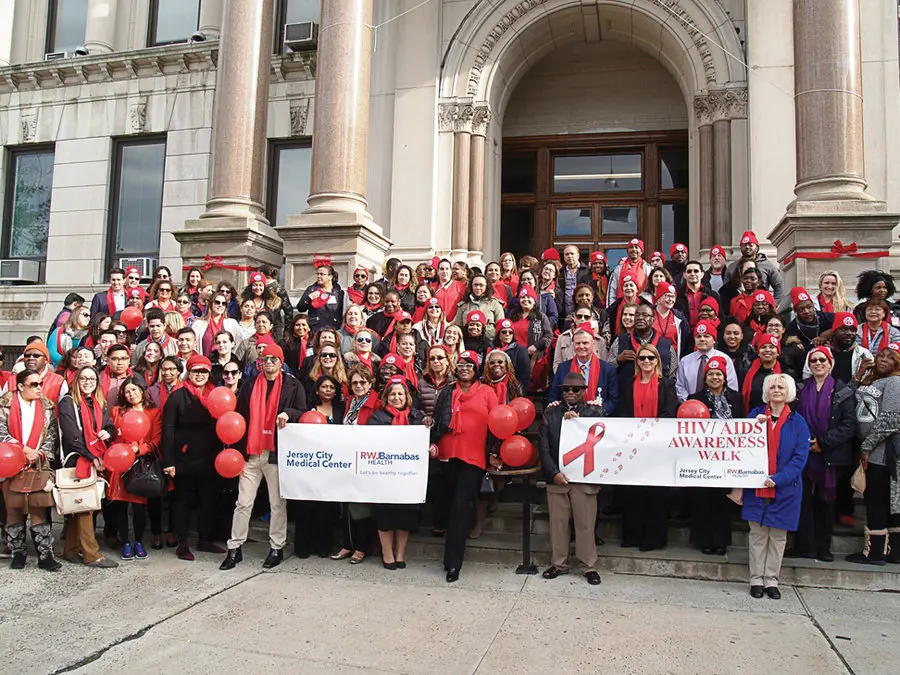“It’s raining, but there’s not a cloud in the sky,” Bruce Springsteen once sang, reflecting the horrible aftermath of the attacks on the World Trade Center on Sept. 11, 2001. Springsteen was pointing out the irony that on one of the clearest fall days in September, the sky was filled with fire, smoke, and people.
For those walking through the streets of downtown Jersey City on World AIDS Day on Dec. 1, the sky was equally clear, although the air had the chill of late fall. Yet more dreadfully over the hundred or more people taking part in the annual event, a cloud of doubt hung. This was not because their efforts since the original outbreak of AIDS have been in vain, but because a haze of doubt hung over the future and the threat a changing administration in Washington DC might have on the effort to continue successes the last two decades have made against AIDS.
According to county officials, who allocate state and federal funding for AIDS and HIV assistance, federal money has been reduced over the last decade. Many anticipate even steeper drops in funding under the new administration. This combined with the promised decommissioning of the Affordable Care Act (commonly called Obamacare) could mean serious setbacks in the fight to halt the spread of AIDS.
This affects not only treatment, but also awareness programs that help reduce the number of new HIV infections. Part of the reason for loss of funding is that under some of the reporting regulations changes made about seven years ago, HIV is no longer counted. This means that thousands of Hudson County residents infected with HIV are not considered relevant for the funding.
A need to be aware
To commemorate World AIDS Day and rally support for the cause of fighting AIDS, the Jersey City Health And Human Services Department partnered with Jersey City Medical Center for a walk starting at the hospital and ending up at City Hall, where speakers gathered to remember those who have perished from the disease and to outline plans for the future.
“We are committed to be a leader in this fight.” – Mayor Steven Fulop.
____________
At City Hall on Grove Street, the multitude gathered on the steps, drawing even more attention before reassembling in the City Council chambers for a prayer vigil, ceremony, and information session.
“We are committed to be a leader in this fight,” said Mayor Steven Fulop.
Making progress
Along with local officials, the walk and subsequent rally included Cathleen Bennett, commissioner of the New Jersey Department of Health.
Bennett said there are 37,000 known cases of AIDS/HIV in the state with about 5,000 of these in Jersey City.
“We have work to do,” she said. “But we’ve made progress.”
She said there has been a 37 percent decrease statewide since 2005.
More importantly, she said, news from researchers in South Africa offers real hope for the future in an announcement that they are on the brink of developing a vaccine against AIDS.
This would be as monumental as the development of a vaccine for polio in the 1950s and many of the advances made in finding treatments for cancer in the 1970s.
Many of those who put on the red baseball caps and red scarves symbolizing unity against AIDS remembered the bad old days in previous decades of seemingly hopeless struggle against the disease. In the 1980s, HIV was a death sentence, recalled Linda Ivory-Green, community health services coordinator in Jersey City. People had no hope, and the only available medicine was a complicated cocktail. Statistics show that 90 percent of those suffering from AIDS in 1989 died. Over the last 15 years, nearly 85 percent of people diagnosed with HIV survive. But it is still a deadly disease.
In 2013, Jersey City had the sixth highest rate of AIDS in the state, while New Jersey was among the states with the highest in the nation with reported cases. Revolutionary drug breakthroughs over the last decade, massive awareness campaigns, needle exchange programs, and other initiatives have helped reshape the field, making it easier to treat people with the disease and prevent new cases.
Stacy Flanagan, director of the Jersey City Department of Health and Human Services said the goal continues to be to reduce new cases to zero.
While Bennett said the percentage of new HIV cases is in decline, other sexually transmitted illnesses are on the rise in New Jersey.
“We have to raise awareness,” she said.
Angelo Estrada, director of outreach for The Van Vorst Neighborhood Association, said schools need to be more involved in teaching about HIV prevention.
“It’s still a taboo subject for the most part,” he said, noting that increased drug use as well as unprotected sex still puts people at risk. “Parents often are in denial. They don’t want their kids to get tested.”
Al Sullivan may be reached at asullivan@hudsonreporter.com.
